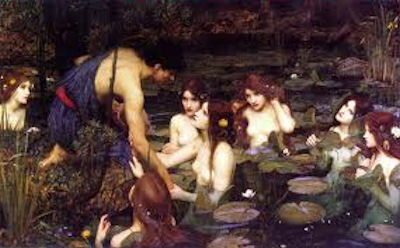
Introduction 2B
Myth, The Source of all* Storytelling
(*All, except Fairy Tales.)
If every Fairy Tale is a journey,
Myth is an effort to make sense of where we
find ourselves at journey's end.
Making sense presupposes an ability
to reason. Reasoning assumes the capacity to think.
And thinking involves the use of words, those marvellous
and mystical, unseen and unique life-altering entities
sometimes unkindly described as lies.
If Fairy Tales tell us who we are,
Myth is the raiment — the tissue of falsehoods,
misdirection and concealment — with which we cover
up our frailties and flaunt our attributes.
Just as we demand from Fairy Tales certain
characteristics in order to qualify for the title, so Myth
has its own essential elements, often ascertained in
direct opposition to Fairy Tale, and beginning with the
latter's Transformatory Journey:—
- To begin with, there's no Once upon a time
in Myth. Fairy Tales are
told to us; we read Myth
alone. Freed from dependence upon adult benevolence
for our entertainment — and everything else — we lose the
perception of our solitariness, and our helplessness as well.
No longer needing the security of Once upon a
time, we are enabled by Myth
to move on to the uncertainty of more universal
themes.
- Secondly, Fairy Tales' Happily ever after does
not mean growing up. If Fairy Tales are about a hero
or heroine who remains constant amid a journey of continued
and shattering change, Myth
concerns a more or less adult protagonist caught
in static and implacable forces that forever
alter him or her. Narcissus,
and Apollo and Daphne
come to mind, because what could be more static
and rooted than a flower, or a tree?
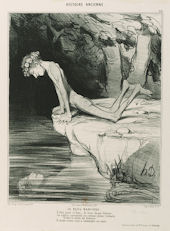
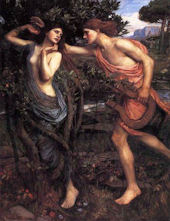 — The fate of
Narcissus can be
understood as a simple narrative, as a small morality
tale on the dangers of loving oneself so thoroughly that
we become fixated on our reflected glory to the exclusion
of everything else, or as an analytic tool to describe
the workings of a severe neurotic disorder, depending
upon the capacity for intellectual sublety on the part of
the reader.
— The fate of
Narcissus can be
understood as a simple narrative, as a small morality
tale on the dangers of loving oneself so thoroughly that
we become fixated on our reflected glory to the exclusion
of everything else, or as an analytic tool to describe
the workings of a severe neurotic disorder, depending
upon the capacity for intellectual sublety on the part of
the reader.
—Apollo and Daphne
is capable of even deeper complexity of meaning, from our
natural repulsion toward an overly enthusiastic pursuit
by an unwanted lover, to the psychological phenomenon of
figuratively turning ourselves into unresponsive wood
when submission to superior physical force is
unavoidable. And all this effected by the use of
words as the medium of transformation, rather than
of narration.
________________
- Aloneness. In Hansel and
Gretel, brother and sister are both
capable of the detachment necessary to see the sibling as
a fully rounded person, shockingly uncharacteristic of a
Fairy Tale, though not entirely uncommon for Myth.
One way in which multiple points of view are shown
in Myth is through the use of
multi-episode narratives, containing mostly the same cast
of characters but from the perspective of a different
protagonist for each section — unthinkable in Fairy
Tale. (Reading
Homer, watching Star Trek; what more could anyone
ask of life? Or of Myth?)
- Prototype versus uniqueness of character. Fairy Tale
characters are unique by virtue of their circumstances
and the detail which surrounds each story. Myth
will involve prototypes: Little
Red Riding Hood versus Prometheus, for example.
- Acceptance of Change. By the time we are
ready for Myth
we have gained sufficient confidence to contemplate with
equanimity the prospect of change, in ourselves as well as in
our circumstances.
- Strangers along the route. Strangers
along the route
of a Fairy Tale generally exist in order to facilitate
the unfolding of the plot. Strangers in Myth
are the plot, with their warnings
and foreshadowings, their pursuits and strategems and
their trickery. Strangers may disappear in Myth,
but we have always the strong suspicion that they will come back
as soon as a hero becomes comfortable in his or her situation.
- Creatures with magical powers.
In Myth,
magical creatures such as witches, ogres, dragons, trolls
and the occasional fairy are often replaced by gods and
goddesses, not always an improvement for the fate of mortals
awaiting their erratic but implacable pleasure.
- Detail. Without its inseparable detail,
there is no Fairy Tale. Myth being a
creation of words used to convey complex ideas rather
than simple narrative, its details can be omitted, added
to, mocked, converted to lyrics, confused with historical
fact, and otherwise manipulated at will.
- Truthfulness: There's no lying in
Fairy Tale. Children hearing a Fairy Tale have no reason
to doubt its essential truthfulness. Myth,
on the contrary, existing simultaneously on many
different planes, can be, and frequently is, subject to
immense variety in interpretation.
- Irony: There's no irony in Fairy
Tale. And one of the signs that
a child is ready to move up from comfortable Fairy Tale
to unsettling Myth
is the development of the ability to appreciate the
delicious properties of irony.
- Innocent amorality: There's no right
and wrong in Fairy Tale. If Fairy Tales are marked by an
innocent amorality, we see in Myth the beginnings of
a higher authority to whom a wronged mortal can appeal for justice:
all-powerful Zeus, greatest of the Olympian gods, is often shown as
solicitous of the well-being of mortals in need of his assistance and support
— although in cases where wrongdoing involves Zeus himself, things
frequently become more complicated.
- Tolerance: There's no preaching in Fairy
Tale. A fable, with its prim lessons
and worthy instruction, is never a Fairy Tale, but can
often be a Myth, where words
are used as much to conceal, instruct, and misrepresent
as to narrate:— Atlas, for example,
tricked into holding the world on his strong shoulders,
and accepting the necessity of continuing the job because
there is no one else to do it, never could be presented as
a character in a Fairy Tale. Nothing is demanded of the Fairy
Tale listener but undivided attention, and the concept of duty does
well to wait for a mind more suited to the complexities
of Myth.
- Subterranean Meaning. Meanings in Myth
are hidden and sophisticated, but unlike Fairy Tale we
sense at least a seeming effort to make some kind of
sense of life's enduring mysteries. (Why should one
person die in infancy, for example, while another lives
to be 100? For ancients the answer is as simple as the Myth
of The Moirae, three white-robed Spinners, one of
whom, Atropos, decides on the
manner of death of each mortal being, cutting the thread
of life with her shears when she decides it's time.)
- — This in contrast to Fairy Tales, which are
themselves the
unrevealable mystery.
* * * * *
In conclusion:
— If
it's true that all storytelling is based upon
Fairy Tale and/or Myth,
then it should be possible to examine our five chosen
artistic works in conjunction with at least one
particular representative of the assumed source.
Except that I've already proven
the rule by exception with Dear Frankie,
neither Fairy Tale nor Myth, but just itself.
Meanwhile Blackpool
so successfully proves my rule that I've been forced
to deal directly with relevant Fairy Tale and Myth
in my treatment of the six Episodes of that BBC
television miniseries.
Fortunately I've been more
successful in separating Pride and Prejudice
from its possible Fairy Tale and Myth forebears,
beginning with Fairy Tales and
Pride and Prejudice in the next section.
[July 2007, text only
WebPage last amended
February 22nd, 2013]
________________________
-
Top of this Page
- Introduction 2B:—
Myth
-
Main Page – Index
- Main Page – Index
-
HomePage-2
- HomePage-2
Fairy Tale and Myth
-
Previous Page
- Introduction 2A:—
Fairy Tales
-
Next Page
- Fairy Tales and Pride and
Prejudice:—
Not Cinderella


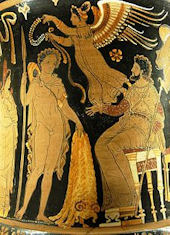
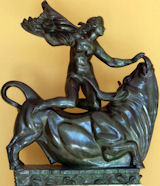


 — The fate of
Narcissus can be
understood as a simple narrative, as a small morality
tale on the dangers of loving oneself so thoroughly that
we become fixated on our reflected glory to the exclusion
of everything else, or as an analytic tool to describe
the workings of a severe neurotic disorder, depending
upon the capacity for intellectual sublety on the part of
the reader.
— The fate of
Narcissus can be
understood as a simple narrative, as a small morality
tale on the dangers of loving oneself so thoroughly that
we become fixated on our reflected glory to the exclusion
of everything else, or as an analytic tool to describe
the workings of a severe neurotic disorder, depending
upon the capacity for intellectual sublety on the part of
the reader.